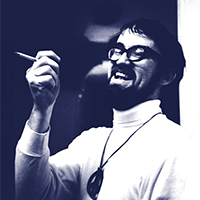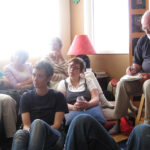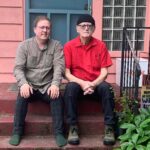Leahy’s Lessons from 60 Years of Organizing
A brief synthesis by Stephanie Guilloud
Organizers’ histories are intentionally obfuscated. Our stories are simplified, and our triumphs are turned into passive voice. The strike began and ended. The development was stopped. The buses were desegregated. The U.S. Social Forum happened. Organizing histories are invisibilized because collective action threatens the structures of power. And just like there are names and addresses of the enemy forces who make decisions that endanger, harm, exploit, and erase, there are names and addresses of the people who organize to fight power and build power.
Dan Leahy is the name of one of those organizers.
He organized people. He organized information. He organized conferences, convergences, and educational institutes. He organized delegations. He organized money to make it happen.
What we lose when we lose an organizer’s history is the ‘how we make things happen’ usually against great odds and fierce opposition. We lose the map, the guiding questions, the playbooks. And we need good plays. We need to understand different fields and how to play on them to win – whether it’s how to run a candidate accountable to the people or how to stop gentrifying developments from displacing people, neighborhoods, and ecosystems or how to shut down the World Trade Organization. We need plays for the short campaigns and for the long game.
Dan modeled his 60 years of organizing work on historic people and plays, drawing on the radical agrarian populists fighting the economic elites putting them into debt, and the Teamsters, organizing truck driver sections down the West coast to mimic how the freight moved.
Dan studied power and how to build it with people from the bottom up. He believed in the rank and file more than the union bosses. He believed in challenging hypocrisy and corruption with truth and strategy. He believed in the reality, not just the possibility, of changing the shape of our world.
Dan was 55 when I was 22 and picked him up hitchhiking on Division Street in Olympia, Washington. He was a professor and I was just about to graduate from The Evergreen State College. He offered me a job later that week – over whiskey at Ben Moore’s – organizing a conference to expose the World Trade Organization. We worked together for the next four years until I moved back South to organize in the place where I am from.
Just as Dan studies the organizing history of the Northwest, we in the South study the historic plays of SNCC and the Montgomery Bus Boycott. Both examples include many organizers, leadership, and methods that have been erased or hidden in such deep ways by power structures as to fool a nation that the civil rights movement was sparked by a woman who was tired, instead of a woman who was trained to fight. We have heard of Rosa Parks but not as a woman who worked with organizers like JoAnn Robinson (who we don’t learn about) and all the organizations and churches and women’s committees. They had tested the strategy, learned from the errors, and were ready to move. The Montgomery Bus Boycott story is not about one woman but about hundreds and thousands of people who moved together and won. I always find that to be the better story. The true story.
As part of a lifetime of practice, Dan learned many lessons. In a time of confusion, division, and increasingly dangerous individualism in 2022, Dan Leahy’s lessons on organizing can contribute to our movements for liberation and dignity.
As one of Dan’s many staff organizers who later became a co-teacher, a collaborator, a running buddy, and a friend, I offer here an incomplete synthesis of his methods and lessons. This is my perspective after two decades of participation and witness. And a lot of time in his basement.
Dan believed in documentation. He saved every piece of paper tied to his organizing eras over time. He was famous for his binders, and they lined the walls of his downstairs office. Carefully chronicled histories of his work, letters to and from enemies and friends, strategy papers, evaluative analysis after the fact, and charts. Lots of charts to make sense of relationships, analyze the information, and shine light on the significance of the thing.
Dan Leahy’s work offers a sharp and clear practice of engagement with reality. He assessed the situation, researched the details, prepared the ask, gathered the people, and took action. The fight is always related to what is already happening and what could happen. The way he described organizing is immediate and tangible, but it is also part of a bigger picture of power relations.
What kind of organizer?
One way to articulate Dan’s definition of organizing could be: changing a harmful situation to an arrangement that is better for the people who experience that harm. Dan included imagination and vision, rooted in historical realities. “Organizers have to have vision. You imagine something first – some form, some shape, and you put it out there. You see if people want to help fill it up. Sometimes you can, sometimes you can’t.”
When Dan was on an organizing drive, it was all he talked about and thought about. The details of the power imbalance, the rudeness of the enemy, the difficulty in getting people to sign on and support, the shape of the vision.
In some ways, he made it seem simple. When he talked about it, the terrain and purpose seem clear.
1) Investigate and research the situation.
2) Gather people to understand and learn.
3) Connect to historical precedent or examples.
4) Create a shared vision.
5) Make a plan
6) Train up the people to act.
7) Take action to challenge power.
8) Take power with support and accountability from the people.
9) Take a picture (to remind ourselves WHO we are).
10) And for god’s sake make a binder (to remind ourselves HOW we did it).
An organizer organizes.
When I talked to Dan about organizing, it wasn’t a lot of theory. Not to say that his practice was without ideology or politics, it’s just that that’s not what we talked about. The bigger picture is assumed. Capital moves to protect itself and continue expanding. The State reconfigures to maintain control and support capital. Racism is a systemic horror baked into institutions; it infiltrates movement and social life in the most insidious ways. And on the flip side, working people and oppressed people can build power. They always have and always will. But let’s get to the details.
The Oil Train fight is a good example. Dan’s organizing campaign to stop the oil companies from using trains as above ground pipelines is an example of his organizing practices and the work it takes to make something happen.
What are the steps? He finds out about oil trains carrying crude from the Bakken in North Dakota. He wanted to know more. He proposed and taught a class at Evergreen called “Virtual Pipelines” as a way to investigate the situation further, engage people who can help and test if people are outraged.
He started tracking the train routes and drives to meet with every mayor who had the trains going through their towns. He alerted them to the dangers and organized them to fight locally to stop the trains from coming through. When he told me he went town to town and met with the mayors, I really paused.
This was the difference – this set of actions separates the organizer from the talker. His way was to witness and be with the problem and move directly with the people affected by it and in position to do something about it. His confidence was bolstered by study: he asked for a meeting and came prepared with the facts and the information that they didn’t have. He made a case and offered a solution. When he talked with each person, he refered to the last person he met with, to show that there is rising concern and potential coordination to stop the problem. This direct engagement with people is fundamental but also often missing from organizing, especially in this online moment.
For this oil train fight, Dan followed the model of a campaign in the 1980s when he organized the electoral take-over of enough Public Utility Districts to stop a state-wide nuclear power program in Washington.
He didn’t stop with the mayors. He convened a Solidarity Roundtable to bring together forces he identified – all those affected and fighting the passage of the oil trains, including and specifically: indigenous tribes whose land it is, firemen who do not have the equipment or safety protections to fight the fires, train operator unions running 120 cars of crude oil without buffers or support, environmental activists, and small town elected officials.
Again, they didn’t meet to talk about it. They met to identify Port Commissions with seats up for election. They found a few folks to run for port commissioners. Dan found a good history of using the ports as food hubs and public gathering spaces, and sent a copy of that history to each person running. The opposition spent major money to run against them; there’s no limit on contributions in port races.
The oil train opponents won several seats. They stopped the oil trains, and they closed the biggest marine transfer station in the country. Two newly-elected Port Commissioners refused to renew the lease and stopped new export platforms.
The oil train example is a window into Dan’s practice of organizing. (His article for Works in Progress, “How to Stop an Oil Train” is here.) To tell his story is to weave in a bigger history and the details of people and place, it’s not just a series of campaigns with victories and losses. Dan was a student of organizing, of history, rebellions, and the people who make things happen.
When Dan and I were together in Ireland in 2015, his homeland and a big part of his identity, we studied Thomas Clarke, one of the key organizers of the Easter Rising of 1916. The Easter Rising is famous as an anti-colonial uprising that took over major institutions, held several counties militarily, and fought off the occupying British army. They were ultimately defeated and Clarke was executed by a firing squad.
Yet their valiant effort sparked the revolution that eventually led to Ireland’s independence. Not that many people talk about Thomas Clarke. And very few know Kathleen, his wife. I read her autobiography upon Dan’s insistence and learned about her ferocity and organizing alongside her husband and the Irish republicans. She contested that Clarke was actually the first president of the Irish Republic, not Patrick Pearse, who was the front man and a better orator.
Dan and I walked past the General Post Office in Dublin which was the headquarters of the rebellion and holds that kind of magic that is imbued in regular everyday places that have served in revolutionary capacities when needed. Dan told me the story of the guys Thomas was working with, and how they had to convince him to be the first signer on the Proclamation of the Republic – despite his refusal of military rank or title. “Nobody ever knows the organizer.”
We toured the cemetery where the rebels mobilized during a funeral after the British repressed all meeting spaces. The tour guide performed Pearse’s impassioned speech. It’s easy to remember the guy who makes the speech (Pearse) and forget the guy who organizes the attendants to rise up the next day (Clarke).
Thomas Clarke and the Easter Rising did not succeed, but that work and bravery served as a turning point in a longer Irish history against colonialism. That may be one reason organizers aren’t heralded or remembered well – their stories are complicated and do not fit easy narratives of good guys, bad guys, and easy victories.
The best organizers learn & evolve with those they work with.
They transform as the moment calls for it, and they are not always the same person throughout time.
Dan’s lessons included losses and setbacks and deep betrayals. But the course of the organizer’s craft stays true and deserves to be remembered. For all the same reasons that artists study artists, that writers read other writers, that scientists reference each other’s studies, that musicians listen to good music. I study organizers to recognize my own unique contribution to the craft. And to learn how to do it better.
Dan was in a constant state of curiosity, to understand and to make sense of the situation. Not for knowledge’s sake but to make decisions about whether or not to align with an effort, to improve tactics, to expand strategies. When Dan and I talked about organizing, the questions were not the jargon of nonprofits and social justice. Instead, the questions were: “What do you do?” – “Do they have people?” – “Are they interested in power?” – “What does it mean?”
I have to pause before answering his questions to consider my response. The questions are not tests, but I do feel like I have a responsibility to tell the truth because the stakes are high, and he’s never been fucking around. He always asked: Is it real? And I think what he meant: Is that formation or person accountable to some base of people or frontline of experience? Does that project have legs and build upon itself towards some desired outcome? Does it lay out a plan and then implement that plan? And like he learned from the Quakers: Does the action you take build movement? Does it bring people in?
There are many ways to engage the world that are safer than organizing. With activism or academia, you just have to know things and have opinions or concerns about them. It’s harder to fail. But the lessons of Dan Leahy’s organizing work over the last 60 years are a guide for how to engage the world and actively transform power structures towards an arrangement that working people deserve.
This synthesis of the organizer’s history cannot capture, and does not intend to, the stories as they are told, as he tells them. You have to earn that. Drink whiskey with him, stay up late, and listen. Like many great organizers, he was an incredible storyteller. You can glean lessons from not just the words but the way he talked about people he admires or good lines that show strength or wit. I am always caught off guard by the rawness of the lessons. They are razor sharp and also messy, as people’s movements are.
If you listen long enough, you learn that the real measure of the work is the heart. The veil shifted when he told a story about people coming together and winning. A detail that was about women committing to a fight and standing up and singing the same song about rising up like bread. A sorrow edged with rage about the injustices done to people, any and all people, who are abandoned and disrespected. He loved working people. He loved people. And believed in them, as he believed in himself.
The list and the ask.
We talk about “the list” and “the ask” often. Key components of organizing. To build a list of people and engage them. He reminded me: Know what you’re asking for. Know who you’re asking. Make it clear. (And make sure they know who to make the check out to and where to send it, if you’re asking for money). Recently, I asked if he ever got nervous when making a big ask of any kind. He shook his head, “I was always confident. I believed in what I was asking them to do.”
What makes that confidence possible? How did this organizer come to be? Dan believed in history. He used it as a guide and an inspiration. And maybe that is what I aim to do with this synthesis, share an organizer’s history to guide us, as organizers, through challenges and inspire us to believe in ourselves and what we do as much as he did.
Continue to Framework for Organizing



